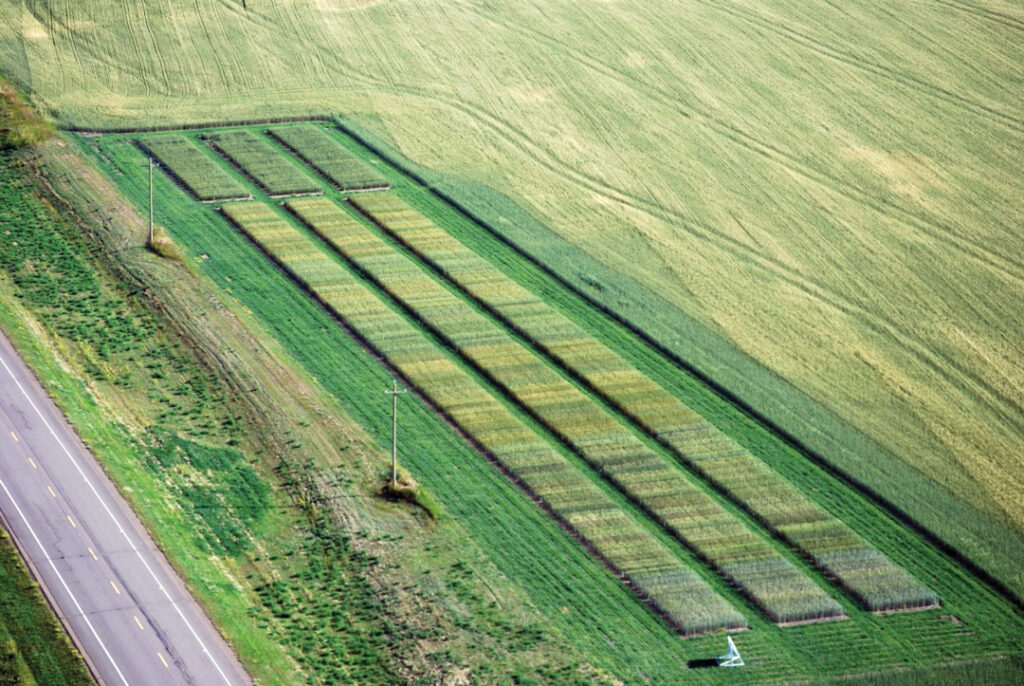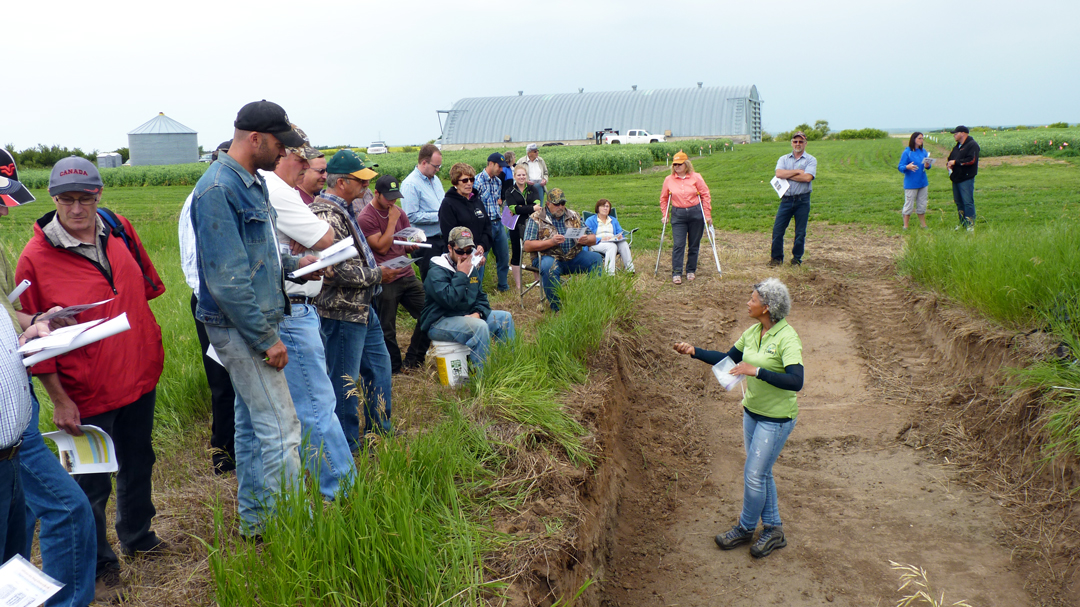PLOT TO PRACTICE
BY MELANIE EPP • PHOTOS COURTESY OF DIANNE WESTERLUND
When Greg Newman is pitched a new product for his 3,000-acre grain farm in Alberta’s Peace Region, the first question he asks is: “Has that product been tried and tested up here?” Without local data, he’s not buying. “What works in southern Alberta can work totally different up north,” said Newman, who farms alongside his two sons near Fort Vermilion.
For Newman, credibility starts with context. That’s why he relies on the Mackenzie Applied Research Association (MARA), his local farm research group, to test new ideas and validate emerging practices under Peace Country conditions. It’s also why he chairs the organization and served as board chair of the Agricultural Research and Extension Council of Alberta (ARECA), the umbrella group that connects the province’s eight regional applied research associations. “I believe in what these organizations are doing,” he said. “They’re not selling anything. They’re just trying to find the truth and helping farmers make better decisions.”
Across the province, groups such as MARA, Chinook Applied Research Association (CARA) and Gateway Research Organization (GRO) help grain farmers adapt on their own terms through farmer-led trials, regionally grounded extension and a deep understanding of what works where.
PEACE COUNTRY EXTENSION
MARA’s work centres on practical research and extension tailored to conditions in Peace Country. The association has also offered workshops on farm succession planning. At the north end of the region, farmers in the association’s catchment area are far distant from agricultural facilities to the south. “For me to go and get help with [succession planning], I’d have to drive six to eight hours,” said Newman. “MARA brings that expertise here, five minutes from home.”
Newman described MARA’s research as independent, with trials that respond to the needs of the farmer rather than commercial priorities. “It’s not company-led research. It’s not driven by a salesperson. It’s not done by somebody who’s selling the product or trying to get a paper published.”
MARA conducts multiple research projects that include soil health benchmarking and regional variety trials (RVTs). Alberta Grains partnered with MARA and additional applied research associations to evaluate the effect of various nitrogen fertilizers on wheat yield and protein. On a MARA research plot, enhanced efficiency fertilizers such as ESN and SuperU are being side-banded at seeding at 70 per cent and 100 per cent of recommended rates. This is being compared directly to conventional urea to determine the impact of rate and timing. In some cases, farmers are directly behind the innovations being tested. “Some of the equipment we’ve designed ourselves,” said Newman. “And we’re asking, ‘Does this work? Can we prove it works?’”
TRIALS AND TRUST
In east central Alberta, encompassing the province’s arid Special Areas and the MD of Acadia, CARA works under a similar principle: until it’s tested locally, it hasn’t been proven. Founded by farmers more than 45 years ago, the organization’s mandate is to tailor research to dryland conditions and deliver results in a usable form.
“Our role on the local or regional level is to connect that research to the producers and then adapt it and maybe fine tune it to the local conditions,” said Dianne Westerlund, CARA manager and forage agronomist. She added that farmers are increasingly interested in holistic management, especially when it comes to soil. To support this demand, the association established the first soil health lab of its kind in Western Canada. The lab helps farmers look beyond N-P-K to assess micronutrients and biological function, and to evaluate the growing number of soil health products on the market.
CARA works with progressive farmers who wish to refine their production practices and sustainably reduce input costs, although everyone benefits from independent and unbiased evaluation of new agricultural products, said Westerlund. Farmers also rely on CARA’s extension work. This includes farm information initiatives such as hands-on field days, newsletters and webinars. The organization examines all aspects of the production puzzle, said Westerlund. It then shares information in a way that assists grain farmers to make better decisions.
Farmers in the CARA region contend with salinity, compaction and limited water retention. The ability to draw on locally tested farm practices can narrow the margin of risk under these challenging conditions. CARA provides informational tools to support good decision-making in a dryland system.

TRIALS GROUNDED IN LOCAL RISK
Further north, GRO serves farmers in Athabasca, Barrhead and Westlock counties, with trial work and events that extend across eight municipalities. Like its counterparts, GRO is farmer-led and focuses on delivery of practical, unbiased research that reflects the region’s soils and seasons.
“We take the risks so that the producer doesn’t have to,” said Andria Carlyon, the organization’s manager. “We’re not salespeople; we just show what works locally.” The GRO research calendar is shaped by the interests and needs of area farmers. This includes trials of humic substances, mycorrhizal fungi and intercropped corn. All are driven by the concerns and questions of farmers who want to know whether new tools such as biologicals are worth the cost.
“We’re testing humics to see how they improve soil health and yields, especially in marginal soils or those with low organic matter,” said Carlyon. In addition to the assessment of emerging farm tools, GRO is expanding its work on soil-borne diseases. The GRO team recently piloted a study of cultural control methods for aphanomyces in peas. While the results were inconclusive due to baseline variability, Carlyon said the work helped lay the foundation for future regional studies.
The organization also contributes to RVTs and partners with Alberta Grains to deliver extension resources for the management of Fusarium head blight in wheat. “Having local fields helps producers trust the RVT data,” said Carlyon. “They know where it comes from and can see the trials themselves.”
Farmland in the GRO catchment area typically has higher organic matter and receives greater moisture than southern Alberta, but a shorter growing season limits crop options. This makes locally adaptated research critical for the selection of appropriate crop varieties and adjustment of management practices.
BUILT BY FARMERS, FOR FARMERS
Behind each of Alberta’s research associations stands ARECA, the co-ordinating body that supports shared programs, policy dialogue and long-term planning. The umbrella structure gives smaller groups a stronger voice with government and funders.
ARECA also administers AgKnow, the Alberta Environmental Farm Plan (AEFP) and co-manages the On-Farm Climate Action Fund (OFCAF). It supports its member organizations with administrative services and training opportunities for staff and also facilitiates the sharing of research results across regions.
“These groups aren’t inventing anything,” said Alan Hall, ARECA executive director. “What they are trying to do is take technology, products and practices, to see how we can best adapt them to the local situation.” In their research projects, the associations work to adapt technologies and practices to local conditions. They ensure this information reaches farmers in ways that support real-world decision-making. Hall believes the strength of the network is that its members maintain independence and local focus. While certain groups lean into soil health or disease management, others focus on rotations, variety testing or economic analysis.
But maintaining this valuable independence takes more than mere co-ordination. It requires consistent funding and long-term vision. Newman said short-term grants make it difficult to retain skilled staff or plan with confidence. “It’s hard to attract people when you can’t promise you’ll still be funded next year,” he said. “We need long-term commitment from funders.”
Such support, he further emphasized, allows associations to build trust with farmers. With it, researchers and association staff can maintain focus on projects that matter.
ALBERTA ENVIRONMENTAL FARM PLAN (AEFP)
With this free, voluntary self-assessment tool, farmers can identify environmental risks and strengthen stewardship practices. Used by more than 5,000 farmers, the AEFP is increasingly required for grant eligibility and is supported by supply chains that seek proof of responsible land management.
AgKnow
Through AgKnow, Alberta farmers can connect with therapists who possess an agriculture background. Built to support mental health and succession planning, the program delivered more than 250 sessions in 2024. Backed by ATB Financial, it helps farmers navigate stress, conflict and farm transitions.
On-Farm Climate Action Fund (OFCAF)
OFCAF supports climate-smart grazing practices across Canada. In Alberta, ARECA delivers the program in partnership with the Canadian Forage and Grasslands Association. While directed toward livestock farmers, it is focused on the growing federal interest in ag-based climate solutions. Crop farms remain largely outside its scope.







Comments